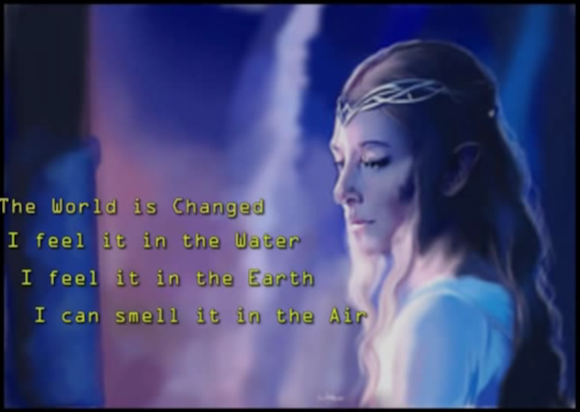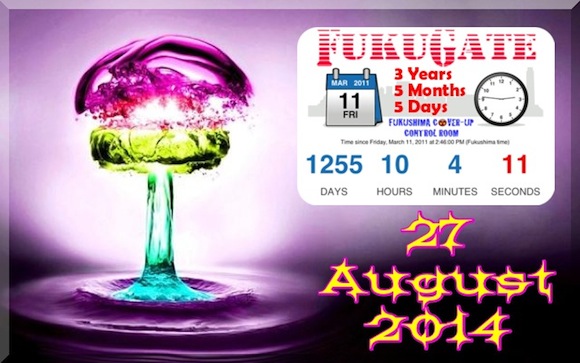It looks like you're using an Ad Blocker.
Please white-list or disable AboveTopSecret.com in your ad-blocking tool.
Thank you.
Some features of ATS will be disabled while you continue to use an ad-blocker.
share:
Major Leak...Unit 1 and Unit 2 Subdrain
They hadn't release any data for several days. Something is going on....
www.tepco.co.jp...
- Purple Chive
They hadn't release any data for several days. Something is going on....
www.tepco.co.jp...
- Purple Chive
originally posted by: Purplechive
Major Leak...Unit 1 and Unit 2 Subdrain
They hadn't release any data for several days. Something is going on....
www.tepco.co.jp...
- Purple Chive
And compare these numbers to August 13th, 2013...a year ago:
www.tepco.co.jp...
- Purple Chive
a reply to: Purplechive
hot particles found hundreds of miles from fukashima, and, they (Japan) are hosting the 2020 summer olympics (shudder)
hot particles found hundreds of miles from fukashima, and, they (Japan) are hosting the 2020 summer olympics (shudder)
edit on 13-8-2014 by research100 because: added a word
So they are going to take the big tent down that they put around Unit.
www.tepco.co.jp...
Now, with the remaining nuclear debris stabilized, emissions are roughly one one-hundredth of what they were when the cover was constructed. It can now be safely removed so that TEPCO can begin removing debris from the operating floor, an essential step toward eventual decontamination and decommissioning.
Removal of the cover is an essential step toward erection of the large overhead crane that will be used to remove the debris, similar to the one currently being used to safely remove fuel from Unit 4. The temporary will be replaced by a structure capable of supporting the crane's weight.
www.tepco.co.jp...
a reply to: BGTM90
www.tepco.co.jp...
Correction: Since October of that year, the Unit 1 building has been shrouded by a temporary cover that was erected to protect the elements from the building and reduce the amount of radioactivity that is escaping.
That's a much better statement and closer to the truth.
I have to dig back through some stuff but it wasn't very long ago that Tepco was warning about huge releases of radiation when the cover was removed. Now of course the closer it gets to the actual removal, the more they begin to downplay any releases of new radiation into the environment.
Not surprising.... it is Tepco after all.
1/100th.... wow.... like Tepco has never lied or understated anything regarding regarding Fukushima and radiation levels. BTW, 1/100th of what? Tepco has never stated (to my knowledge) exactly how much airborne radiation is being released from #1.
1/100th of the previous levels........sounds good unless the the previous level were very high.... 1/100th of a very high figure isn't really saying much... just more of the same ole smoke screen technique that Tepco is so fond of. Unit 1 melted through.... that's why the emissions stack behind 1 & 2 clocks in at 25 sieverts per hour in one location and 10 sieverts an hour in another. Both deadly with minutes.
For example,(from another post) particle 5 came in at 200,000,000,000,000 bq per kg of radioactive material. Lets see... 1/100th of 200,000,000,000,000 comes in at ..... 2,000,000,000,000 bq per kg of radioactive material. Still just a wee bit over allowable guidelines.
Time will tell.... it always does.
ajw.asahi.com...
Previous cleanup efforts have spread more radiation. No reason why this cleanup won't do the same.
www3.nhk.or.jp...
ajw.asahi.com...
Since October of that year, the Unit 1 building has been shrouded by a temporary cover that was erected to protect the building from the elements and minimize the amount of radioactivity that might escape.
www.tepco.co.jp...
Correction: Since October of that year, the Unit 1 building has been shrouded by a temporary cover that was erected to protect the elements from the building and reduce the amount of radioactivity that is escaping.
That's a much better statement and closer to the truth.
I have to dig back through some stuff but it wasn't very long ago that Tepco was warning about huge releases of radiation when the cover was removed. Now of course the closer it gets to the actual removal, the more they begin to downplay any releases of new radiation into the environment.
Not surprising.... it is Tepco after all.
1/100th.... wow.... like Tepco has never lied or understated anything regarding regarding Fukushima and radiation levels. BTW, 1/100th of what? Tepco has never stated (to my knowledge) exactly how much airborne radiation is being released from #1.
1/100th of the previous levels........sounds good unless the the previous level were very high.... 1/100th of a very high figure isn't really saying much... just more of the same ole smoke screen technique that Tepco is so fond of. Unit 1 melted through.... that's why the emissions stack behind 1 & 2 clocks in at 25 sieverts per hour in one location and 10 sieverts an hour in another. Both deadly with minutes.
For example,(from another post) particle 5 came in at 200,000,000,000,000 bq per kg of radioactive material. Lets see... 1/100th of 200,000,000,000,000 comes in at ..... 2,000,000,000,000 bq per kg of radioactive material. Still just a wee bit over allowable guidelines.
Time will tell.... it always does.
The highest level of contamination was recorded in a sample collected between Aug. 16-20, 2013, reaching 50 to 100 times higher than normal levels. TEPCO conducted large-scale debris-clearing work at the plant on Aug. 19, 2013.
Previous research by the farm ministry and Kyoto University also showed that radioactive dust released during the work reached locations 27 km and 48 km from the plant.
ajw.asahi.com...
Previous cleanup efforts have spread more radiation. No reason why this cleanup won't do the same.
The operator of the damaged Fukushima Daiichi nuclear plant says more than one trillion becquerels of radioactive substances were released as a result of debris removal work at one of the plant's reactors.
The plant is believed to be still releasing an average of 10 million becquerels per hour of radioactive material
www3.nhk.or.jp...
Although TEPCO's stricken facility is estimated to currently emit about 10 million becquerels per hour, the utility said that cleanup efforts at the plant’s No. 3 reactor on Aug. 19, 2013, resulted in the release of a maximum 1.1 trillion becquerels of radioactive materials over a period of four hours.
ajw.asahi.com...
edit on R232014-08-13T14:23:03-05:00k238Vpm by RickinVa because: (no reason given)
a reply to: RickinVa
Found it:
ajw.asahi.com...
Bold by me
Found it:
The company said its plans to dismantle the cover on the No. 1 reactor building will be the fastest way to remove wreckage from the site. TEPCO will also spray more anti-scattering agents than usual during the operation.
But the company acknowledged that the procedure will still lead to the release of a large amount of radioactive substances, and the spread of the substances will depend on the weather and the wind direction.
ajw.asahi.com...
Bold by me
edit on R402014-08-13T14:40:57-05:00k408Vpm by RickinVa because: (no reason given)
edit on R412014-08-13T14:41:22-05:00k418Vpm
by RickinVa because: (no reason given)
The plant is believed to be still releasing an average of 10 million becquerels per hour of radioactive material. (If that's a Tepco estimate, then
multiply the 10,000,000 by at least a factor of 5 and you might be close)
10,000,000 x 24 x 1,250 = 300,000,000,000,000 (Trillion) bq released,,,, not counting the huge amount of the initial event. Sad.
Food for thought.
10,000,000 x 24 x 1,250 = 300,000,000,000,000 (Trillion) bq released,,,, not counting the huge amount of the initial event. Sad.
Food for thought.
edit on R342014-08-13T19:34:19-05:00k348Vpm by RickinVa because: (no reason given)
edit on
R372014-08-13T19:37:16-05:00k378Vpm by RickinVa because: (no reason given)
a reply to: RickinVa
the insects plants and animals , 'in the zone', are responding to their new , human created radiation condition. Tepco and the JAPANESE "government" ( WHICH HAVE PROVEN THEMSELVES TO BE SYNONYMIS) ARE PROVEN LIARS .....the safety of the human race and the earth itself hang in the balance of their conduct ....your life is in WHOM"S hands ? the answer is yours...what are you going to do with knowledge
the insects plants and animals , 'in the zone', are responding to their new , human created radiation condition. Tepco and the JAPANESE "government" ( WHICH HAVE PROVEN THEMSELVES TO BE SYNONYMIS) ARE PROVEN LIARS .....the safety of the human race and the earth itself hang in the balance of their conduct ....your life is in WHOM"S hands ? the answer is yours...what are you going to do with knowledge
Some New Pics...
Concerning the "ice wall"....notice all the "sparkies".
photo.tepco.co.jp...
photo.tepco.co.jp...
- Purple Chive
Concerning the "ice wall"....notice all the "sparkies".
photo.tepco.co.jp...
photo.tepco.co.jp...
- Purple Chive
a reply to: Purplechive
I think those pictures are from the trenches that are filled with water, If you open up the pdf they have at the bottom it shows diagrams of the trenches. The link takes you to the Japanese site and I can't find the pictures from the english site, but, the Ice wall is a separate project from freezing the water in the trenches.
I think those pictures are from the trenches that are filled with water, If you open up the pdf they have at the bottom it shows diagrams of the trenches. The link takes you to the Japanese site and I can't find the pictures from the english site, but, the Ice wall is a separate project from freezing the water in the trenches.
Hey everyone -
BGMT90 started a thread called "Fukushima by the Numbers" in which he is trying to compare Fukushima to Chernobyl - he posted what data he was able to come up with, thorfourwinds suggested the first part of this thread had numbers around day 17 of the meltdowns.
Does anyone by any chance remember who might have posted these or where in the thread they might be so they can be relocated and posted?
BGMT90 started a thread called "Fukushima by the Numbers" in which he is trying to compare Fukushima to Chernobyl - he posted what data he was able to come up with, thorfourwinds suggested the first part of this thread had numbers around day 17 of the meltdowns.
Does anyone by any chance remember who might have posted these or where in the thread they might be so they can be relocated and posted?
Well this should make us shudder....
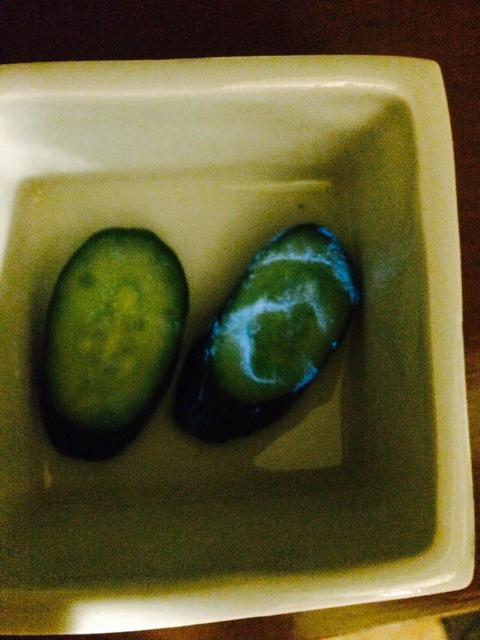
and one with the lights off....
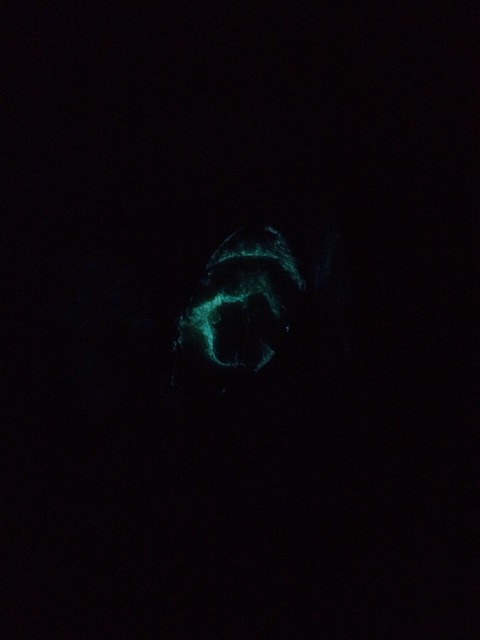
fukushima-diary.com...
A Japanese citizen posted on an internet forum that his pickled cucumber was found glowing in blue on 7/30/2014. The person doesn’t specify the location but states it’s in a prefecture near Fukushima. It looks glowing in the dark as well. The cucumber was purchased 4 days before the posting.

and one with the lights off....

fukushima-diary.com...
a reply to: wishes
I don't think this is actually Cherenkov radiation. But there are a couple of options. Mutated Gene to create Bioluminescence. I really don't think it is this because as you can see only half of the cucumber is glowing you would expect the whole cucumber to glow if it was genetic. Then there is Phosphorescence. Some Chemical such as Zinc Sulfide or Strontium aluminate absorb radiation and reemit them as visible light. Then there is Chemiluminescence in which the light is emitted do to a Chemical reaction like white phosphorus. Or there are Scintillation reagents which are reagents that when excited by energy rich radiation emit light. Which are used to detect radiation.
a picture of Strontium aluminate
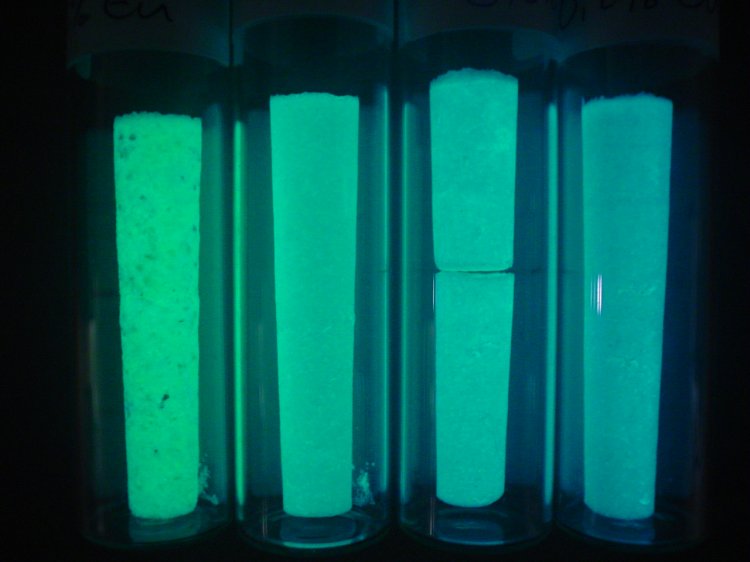
a picture of Bismuth germinate crystal a Scintillation regent
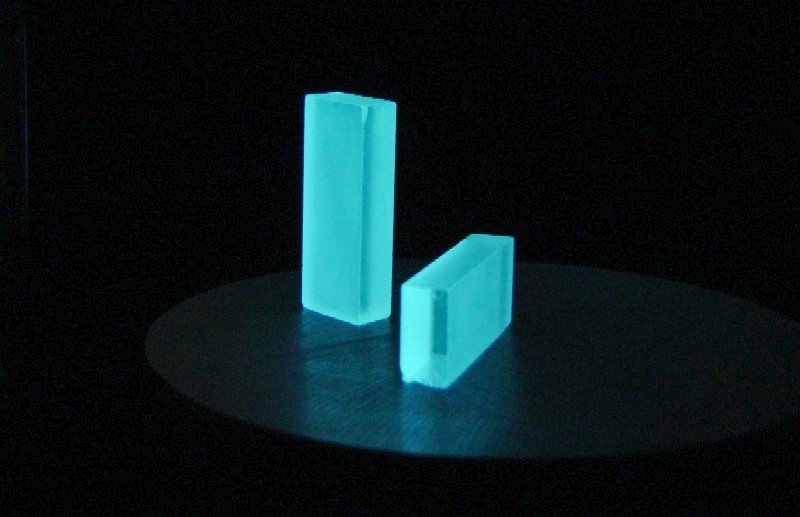
I don't think this is actually Cherenkov radiation. But there are a couple of options. Mutated Gene to create Bioluminescence. I really don't think it is this because as you can see only half of the cucumber is glowing you would expect the whole cucumber to glow if it was genetic. Then there is Phosphorescence. Some Chemical such as Zinc Sulfide or Strontium aluminate absorb radiation and reemit them as visible light. Then there is Chemiluminescence in which the light is emitted do to a Chemical reaction like white phosphorus. Or there are Scintillation reagents which are reagents that when excited by energy rich radiation emit light. Which are used to detect radiation.
a picture of Strontium aluminate

a picture of Bismuth germinate crystal a Scintillation regent

edit on 20-8-2014 by BGTM90 because: (no reason given)
Hmm... I came across this website that seems to be putting out plausible results of studies - I am wondering if anyone has opinions as to the validity
of these findings/data? For the most part what I read from them is things aren't so bad after all... (yet?) Is a lot of information there which I
admittedly have read in its entirety, I skimmed through it. Dunno... opinions anyone?
fukushimainform.wordpress.com...
For example:
fukushimainform.wordpress.com...
For example:
The purpose of this post is to report measurements of radioactivity in fish caught off the west coast of Canada based on the work of InFORM team member Dr. Jing Chen. A collaborative effort between Health Canada, Department of Fisheries and Oceans Canada, and the University of Victoria was published in May 2014 in the peer-reviewed, open-access scientific journal Radiation Protection Dosimetry (link). The authors examined the activities of cesium radioisotopes (134-Cs half-life ~2 years and 137-Cs half-life ~30 years) that were released in large quantities due to the triple reactor meltdowns at Fukushima Dai-ichi Nuclear Power Plant in 2011 as well as a naturally occurring polonium isotope (210-Po) that can pose radiological health concerns for human consumers of marine fish. Samples of chum and coho salmon, halibut, sablefish and spiny dogfish were analyzed and none were found to contain detectable levels of Fukushima derived radionuclides. Radiation doses to human consumers were determined by assuming a conservative worst case scenario where Cs isotopes were present at detection limits of the measurement and found to be 18 times lower than doses attributable to the naturally occurring, alpha-emitter 210-Po. The authors conclude that the radiation dose from Fukushima derived isotopes present in fish caught in Canadian waters represent a very small fraction of the annual dose from exposure to natural background radiation. Based on these measurements, at present, Fukushima derived radionuclides in fish do not represent a significant radiological health risk to Canadians.
a reply to: wishes
well that backs up these results:
ourradioactiveocean.org...
well that backs up these results:
August 14, 2014
Using the most sensitive methods to measure your water samples, we have detected only cesium-137, the “legacy” cesium that remains from 1960s atmospheric weapons testing. This isotope is still in all ocean basins because of its relatively long 30-year half-life, which means it takes a long time to decay away. Levels of cesium-137 in all 43 samples analyzed thus far average 1.5 Bequerels per cubic meter of water, which is equivalent to one-and-a-half decay events per second per metric ton of water. This is a very small number if we compare it to the 7,400 Bq/m3 used by US EPA as the drinking water limit, and the millions of Bq/m3 of cesium detected in the ocean off Japan in 2011 at the peak of the accident, which at that level are of considerable concern for direct negative impacts on marine biota and human health.
The Fukushima reactors also released cesium-134 into the ocean and because it has a shorter half-life (2 years) any cesium-134 detected in the ocean today must have come from Fukushima. Though we do detect this isotope in abundance off Japan, cesium-134 is not YET present in any of the sample collected by citizen scientists along the North American west coast and Hawaii. Our instruments are capable of detecting as little as 0.2 Bq/m3 so the concentration of cesium-134 is below this level.
We emphasize that cesium-134 has not been detected “YET” as it has been detected offshore of North America by Canadian oceanographers. It’s difficult to predict when these radionuclides will arrive onshore because the mixing of offshore and onshore waters is complicated, and not represented in the simple models that predicted the arrival onshore of Fukushima radionuclides this year. The uncertainty in the predictions by these ocean models only emphasizes the importance of collecting samples from along the shores. Remember too that while those models predict increasing levels of both cesium isotopes for the next 2-3 years, the highest published prediction is for 20-30 Bq/m3, or well below what is thought to be of human health or fisheries concern. But it’s important to continue making observations with real data!
ourradioactiveocean.org...
Making Sense Out of TEPCO Data
Haha!!
The purpose of collecting data is to turn it into useful information.
August 23, 2013 Unit 3 Temps:
www.tepco.co.jp...
August 23, 2014 Unit 3 Temps:
www.tepco.co.jp...
The "TE-2-3-69H1" RPV Vessel Wall Above Bottom Head -- (see diagram):
www.tepco.co.jp...
Appears to be almost entirely unchanged in temperature reading in one year comparison.
So what does this tell us?
- Purple Chive
Haha!!
The purpose of collecting data is to turn it into useful information.
August 23, 2013 Unit 3 Temps:
www.tepco.co.jp...
August 23, 2014 Unit 3 Temps:
www.tepco.co.jp...
The "TE-2-3-69H1" RPV Vessel Wall Above Bottom Head -- (see diagram):
www.tepco.co.jp...
Appears to be almost entirely unchanged in temperature reading in one year comparison.
So what does this tell us?
- Purple Chive
I know it is obvious to point this out but I still want to say it anyway. Scientists are paid to do research and to produce reports. If you work for
an establishment which is funded by government or nuclear-related industry you are not going to annoy them otherwise your funding will dry up or you
will lose your job. I dont see any way that any lab can produce unbiased results unless they are independently funded and even then it is probably
very difficult to get results which are not biased one way or the other (pro/anti nuclear)
As far as I can see, it will always be a matter of collecting data from both sides and making an assumption of correctness somewhere in the middle.
I realise that there are very honest, Earth-loving scientists out there, working with integrity but they still have to live and feed their family. Somewhere a compromise has to be drawn and I would not like to have to make that decision as it must be a difficult one.
As far as I can see, it will always be a matter of collecting data from both sides and making an assumption of correctness somewhere in the middle.
I realise that there are very honest, Earth-loving scientists out there, working with integrity but they still have to live and feed their family. Somewhere a compromise has to be drawn and I would not like to have to make that decision as it must be a difficult one.
new topics
-
Steering the Titantic from the Drydock.
US Political Madness: 41 minutes ago -
Paramilitary Leaks - John Williams
Whistle Blowers and Leaked Documents: 9 hours ago -
Some sausage, some chicken, some sauce, some onions and some garlic...and some peppers!
Food and Cooking: 11 hours ago -
Hearing more ambulances lately
Medical Issues & Conspiracies: 11 hours ago -
Los Angeles brush fires latest: 2 blazes threaten structures, prompt evacuations
Mainstream News: 11 hours ago
top topics
-
House Passes Laken Riley Act
Mainstream News: 12 hours ago, 23 flags -
What Comes After January 20th
Mainstream News: 14 hours ago, 18 flags -
Los Angeles brush fires latest: 2 blazes threaten structures, prompt evacuations
Mainstream News: 11 hours ago, 7 flags -
Hearing more ambulances lately
Medical Issues & Conspiracies: 11 hours ago, 6 flags -
Let's Buy Greenland
General Chit Chat: 16 hours ago, 6 flags -
Those stupid GRAVITE commercials
Rant: 15 hours ago, 5 flags -
Paramilitary Leaks - John Williams
Whistle Blowers and Leaked Documents: 9 hours ago, 5 flags -
The more I think about it
General Chit Chat: 12 hours ago, 4 flags -
Canada as a state .. how would it work?
General Chit Chat: 14 hours ago, 4 flags -
Some sausage, some chicken, some sauce, some onions and some garlic...and some peppers!
Food and Cooking: 11 hours ago, 3 flags
active topics
-
Steering the Titantic from the Drydock.
US Political Madness • 1 • : andy06shake -
Canada as a state .. how would it work?
General Chit Chat • 17 • : FlyersFan -
Meta Llama local AI system is scary good
Science & Technology • 48 • : ArMaP -
-@TH3WH17ERABB17- -Q- ---TIME TO SHOW THE WORLD--- -Part- --44--
Dissecting Disinformation • 3968 • : AianawaQ1320 -
Gravitic Propulsion--What IF the US and China Really Have it?
General Conspiracies • 34 • : Lazy88 -
Let's Buy Greenland
General Chit Chat • 16 • : Freeborn -
Post A Funny (T&C Friendly) Pic Part IV: The LOL awakens!
General Chit Chat • 8000 • : KrustyKrab -
Los Angeles brush fires latest: 2 blazes threaten structures, prompt evacuations
Mainstream News • 13 • : BeyondKnowledge3 -
House Passes Laken Riley Act
Mainstream News • 16 • : KrustyKrab -
Planned Civil War In Britain May Be Triggered Soon
Social Issues and Civil Unrest • 16 • : Freeborn

